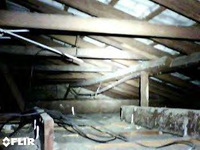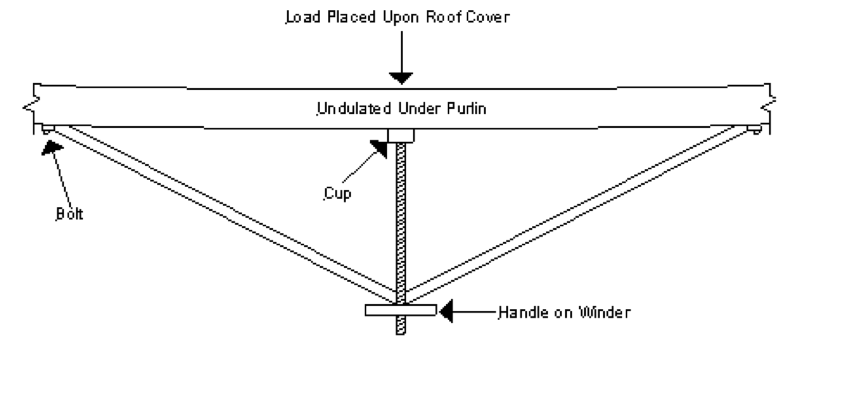Roof Movement; Undulation of Under Purlins
Within a coupled roof framework a load is transferred in the following manner:
- Upon the roof cover;
- Held by the roof battens;
- Supported by the rafters;
- Held in place by the under purlins;
- Supported by the struts;
- Which transfer the load to the foundations via strutting beams or positioning on load bearing walls.
|
What is undulation of under purlins? Undulation is defined as “a regular rising and falling or movement to alternating sides; movement in waves.” This movement is immediately identifiable to suitably qualified inspectors and any movement identified indicates that remedial works will be required at some point. |
Will undulation of purlins always indicate a major structural issue?
No, not always. For example, undulation may be minor and could be the result of excessive loading due to extreme weather conditions such as a storm. Timber is a natural material and as such a certain amount of movement is deemed acceptable, and in the example of the storm a couple of the rafters may have pushed the under purlins down, although this is unlikely to re-occur. However, should any undulation be identified, regular inspections should be conducted to ensure that movement is not the result of under-engineering to the strutting system or poor workmanship in strut spacing compliance.
|
Do I have to replace sections of my roof that show undulation? No you don’t. A typical method of rectification is the use of a bracing system to ensure that the undulation of the under purlin does not continue. This bracing system, is the diagram shown, is commonly bolted between two struts and the handle is tightened until adequate support is applied below the under purlin. The main advantage of this form of remedial works is that it is often far more cost-effective than other forms of rectification and can usually be undertaken by a roof carpenter without the need of demolition or creation of access provisions. However, the disadvantage is that the installation of these systems is not conventional work for many roof carpenters and as such it is recommended the following steps be taken: |
- Ask in which sector do they perform the majority of their work; You want to engage a trade that specialises in renovation, alteration, or repair work, as a roof carpenter that primarily works in the new-build sector may not understand the necessary requirements of the task at hand.
- Ask them if they have done this kind of work before.
- Ask if they are willing to provide any certification for their work; often many trades will be reluctant to sign trade work agreements and will not provide certification for their work. At the bear minimum ensure that they carry public liability insurance and check their ABN is active on ABN look-up.
What can I do to ensure the job has been adequately completed?
Get a building inspector to take a look at the work undertaken and ensure that regular inspections are undertaken to ensure that movement of the under purlins has not continued. It is always advised a suitably qualified inspector carry out this task. After the work has been completed, areas that should be monitored include:
- Check that the bolts are securely fixed and that the timber has not split around the bolts due to excessive strain place upon the under purlin.
- Check that there are no moisture issues within the roof structure; Moisture may cause timber decay or rust to the bolts, which may deem the bracing system inadequate and cause failure.
- Check that the struts are still functioning as intended; Struts may move over time and should always span the full width of the plate or area they are supporting. The load that struts transfer may also begin to cause sagging to strutting beams or cracking to load-bearing brickwork.
In conclusion, although undulation of under purlins is a sign of movement to the roof structure, it does not necessarily mean that the roof is about to collapse or that expensive works are required to remedy this defect. However, depending on the severity of the undulation, caution should be taken, as failure due to this defect is a very real threat. In most instances due to the cost of this work in comparison to the threat, it is recommended that bracing systems be installed and regular inspections are undertaken to ensure minimal chance of failure to the roof structure at your home.


